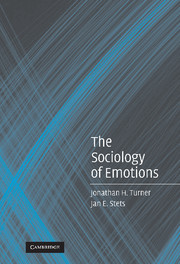Book contents
- Frontmatter
- Contents
- Tables and Figures
- Acknowledgment
- Foreword by Lynn Smith-Lovin
- 1 Conceptualizing Emotions Sociologically
- 2 Dramaturgical and Cultural Theorizing on Emotions
- 3 Ritual Theorizing on Emotions
- 4 Symbolic Interactionist Theorizing on Emotions
- 5 Symbolic Interactionist Theorizing on Emotions with Psychoanalytic Elements
- 6 Exchange Theorizing on Emotions
- 7 Structural Theorizing on Emotions
- 8 Evolutionary Theorizing on Emotions
- 9 Prospects for the Sociology of Emotions
- References
- Index
7 - Structural Theorizing on Emotions
Published online by Cambridge University Press: 05 June 2012
- Frontmatter
- Contents
- Tables and Figures
- Acknowledgment
- Foreword by Lynn Smith-Lovin
- 1 Conceptualizing Emotions Sociologically
- 2 Dramaturgical and Cultural Theorizing on Emotions
- 3 Ritual Theorizing on Emotions
- 4 Symbolic Interactionist Theorizing on Emotions
- 5 Symbolic Interactionist Theorizing on Emotions with Psychoanalytic Elements
- 6 Exchange Theorizing on Emotions
- 7 Structural Theorizing on Emotions
- 8 Evolutionary Theorizing on Emotions
- 9 Prospects for the Sociology of Emotions
- References
- Index
Summary
It is somewhat surprising that sociology, as the discipline concerned with the dynamics of social structures, has developed relatively few theories on how social structures determine the arousal and flow of emotions. For sociologists, social structures are generally viewed as patterns of social relationships among individual and collective actors that persist over time. At the microlevel of social organization, individuals are viewed as located at a position within a set of positions. Most theories conceptualize locations within social structures as status positions, with each position carrying cultural contents (norms, ideologies, values), prestige or honor, authority, and other characteristics. A person's behavior, often seen as role behavior, will reflect the cultural prescriptions, honor, and authority of the position vis-à-vis other positions in the structure.
Another way to conceptualize structure is as a network, with positions being conceptualized as nodes that reveal relationships with other nodes. Rather than focus on the characteristics or incumbents of the nodes per se, the form of the network as a whole is analyzed in terms of certain basic properties, such as density (the level of connectedness among all nodes), centrality (the degree to which connections among nodes run through one or a few key nodes), cliques (the extent to which the overall network reveals subsets of high density of relations among closely connected nodes), bridges (the number of positions connecting cliques), brokerage (the capacity of nodes to control the flow of resources across subsets of nodes in the network), and equivalence (the number and nature of subsets of nodes that reveal similar forms).
- Type
- Chapter
- Information
- The Sociology of Emotions , pp. 215 - 260Publisher: Cambridge University PressPrint publication year: 2005

